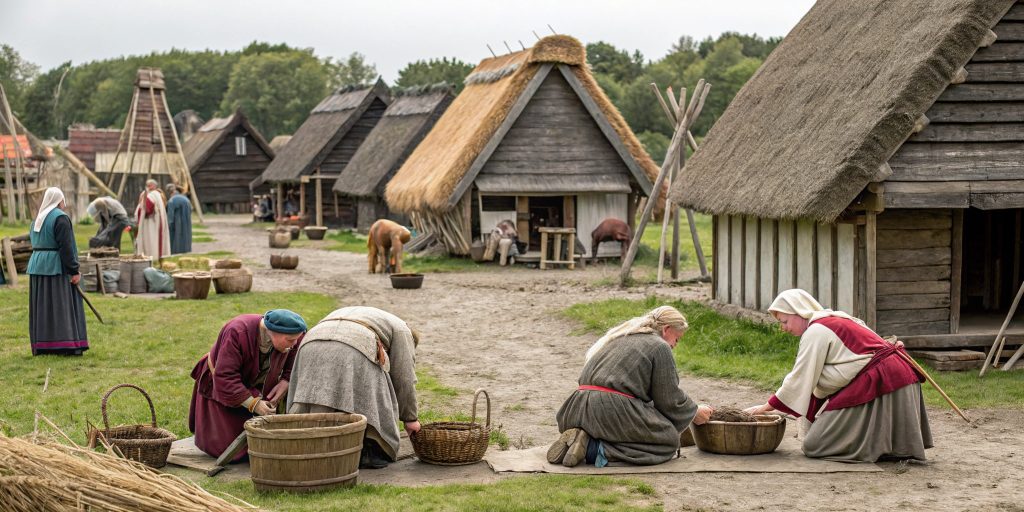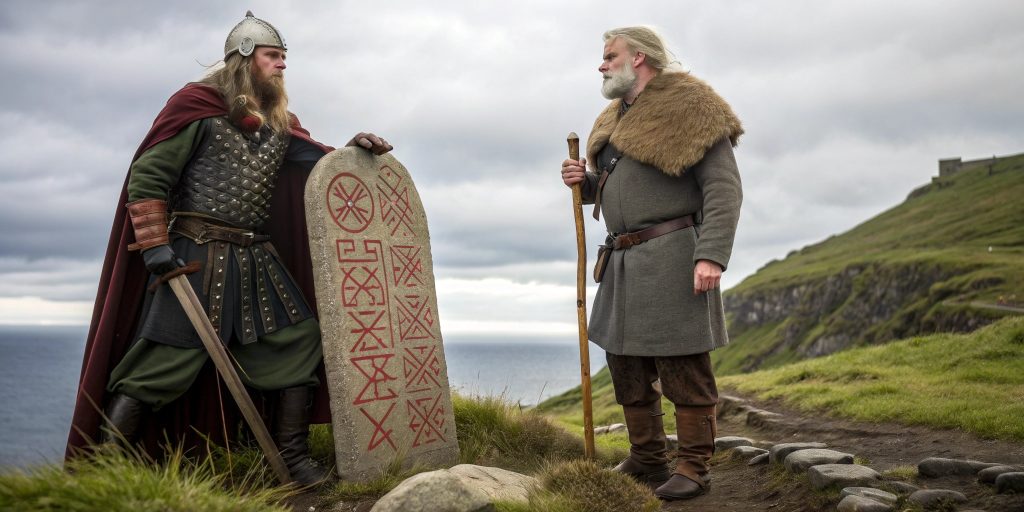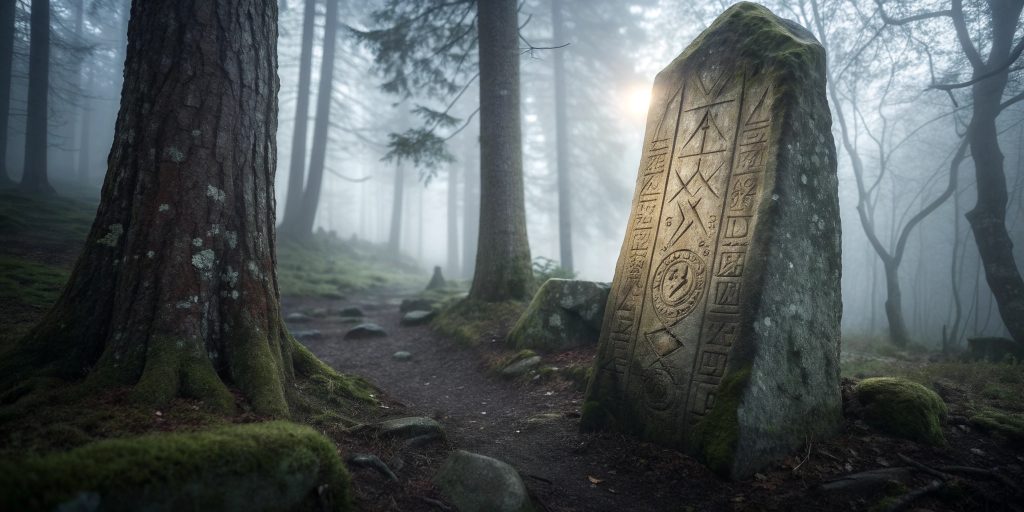Daily Life in the Viking Age, Norse Ancestry, Norse Mythology, Viking Heritage, Vikings
Does Old Norse Still Exist?
Vikings once spoke the Old Norse language. It’s a vital part of Scandinavian heritage, and today, it sparks curiosity about its role in modern times.
Knowing about Old Norse is essential for many. It’s crucial for linguists, historians, and fans of Norse mythology who want to understand the ancient culture’s roots.
This article will examine what is Old Norse language and its importance. We’ll explore its history, language, and how it affects us today.
Understanding the Old Norse Language
Old Norse is a North Germanic language from the Viking Age. It evolved from Proto-Germanic. This shows its rich history and unique features.
It has complex grammar. This makes its sentences exciting and detailed.
Characteristics of Old Norse
Old Norse is notable for several reasons. Here are a few:
- Inflection: Old Norse words change a lot. This is based on their role in a sentence.
- Word Order: The order of words can change. This helps show emphasis and meaning.
- Vocabulary: Its words tell us about the culture and life of its speakers. They include sea, myths, and everyday words.
Variants of Old Norse
Old Norse has different dialects over time. The main ones are:
- Old East Norse: Spoken in Sweden and Denmark. It sounds different from the West.
- Old West Norse: Popular in Norway and places like Iceland. It’s known for its unique features.
- Old Icelandic: A crucial part of Old West Norse. It’s famous for keeping old forms alive.
These dialects show the language’s diversity. They also show how people can understand each other, which helps us see the lasting impact of old Norway.
Historical Context of Old Norse
The Viking Age started around the late eighth century and ended early in the eleventh century. During this time, the Vikings traveled far across Europe and beyond. They met many people, which helped the Old Scandinavian language grow.
This journey spread Old Scandinavian words and sounds to new places, mixing in words from local languages they found.
The Viking Age and Language
In the Viking Age, how people lived in Scandinavian societies was critical to Old Norse’s growth. The Vikings’ travels led to trade and talks with different cultures, which brought new ideas and words into Old Norse.
Old Norse became a way for the Scandinavian people to share their stories and beliefs, a crucial part of their culture.

Old Norse in Written Form
Old Norse moved meaningfully from spoken to written language. The Icelandic sagas were a big help in this change. These stories kept the language and culture alive.
Before the Latin alphabet, runes were used to write Old Scandinavian. This written form helped the language and its stories survive long after the Viking Age and still shapes modern Scandinavian languages today.
Old Norse and Its Influences on Modern Languages
Old Norse has a significant impact on today’s Scandinavian languages and English. It shaped their words and how they are put together. This shows how languages change and grow over time.
Linguistic Legacy
Many modern languages, like Danish, Swedish, and Norwegian, still use Old Norse words. This shows their shared cultural heritage and reminds us of our common roots.
Loanwords in Modern Languages
Old Norse has a significant influence on English, too. Many English words come from Old Norse, which adds to English and shows how cultures meet through language.
- The sky is from the Old Norse word “sky,” meaning “cloud.”
- Window, derived from “vindauga,” signifying “wind eye.”
- Knife, which has roots in the Old Norse word “knífr.”
Adding Old Norse words to English shows the impact of Norse culture. It also shows how languages grow through meeting and changing. Knowing this helps us understand modern languages better.
Dialect Variations of Old Norse
The Old Norse language has many dialects shaped by where it was spoken. Two main branches are Old East Norse and Old West Norse. These branches led to the modern Scandinavian languages, like Old Swedish, Old Danish, and Old Norwegian.
Geographic Distribution
Old East Norse was spoken in Denmark and Sweden, helping create old Danish and Swedish. Old West Norse was spoken in Norway and Iceland, leading to Old Norwegian. This separation led to each dialect’s unique sounds, word forms, and vocabulary.
Differences and Similarities
Despite sharing roots, the dialects have apparent differences. For example:
- Old Swedish and old Danish have different sounds.
- Old Norwegian’s verb forms differ from others.
- Words with different meanings or terms exist across dialects.
These differences show how each dialect developed its path. Yet, they also share common traits from their Old Norse roots.
The Role of Old Norse in Norse Mythology
Old Norse is critical to understanding Norse mythology. Its texts keep these stories alive. They tell us about gods, heroes, and legendary sagas.
Works like the Poetic Edda and Prose Edda show how these stories shape culture. They teach us about values and beliefs.
Mythological Texts
Old Norse texts are the primary sources of Norse mythology. Sagas share epic tales of creation, heroism, and the gods’ end. These stories entertain and teach moral lessons.
They guide how people should act and what the community expects.
Influence on Cultural Narratives
Old Norse mythology has shaped many stories today. Its themes appear in books, art, and movies. Figures like Odin and Thor still inspire us.
They show the power of Norse heritage and identity.
Is Old Norse Still Spoken Today?
Old Norse is no longer spoken daily but still shapes modern Scandinavian languages. Many groups work to keep Old Norse alive, attracting fans and scholars.
Communities and Speakers
People learn and share Old Norse in different places through school programs, workshops, and cultural events. Although these groups don’t speak Old Norse as their first language, they love the language and want to understand their heritage.
This effort keeps Old Norse interesting for many. It shows how much people value their cultural roots.
Importance for Linguists
Linguists find Old Norse critical. They study it to understand how languages have changed over time. Old Norse helps them see how early Germanic languages worked.
By studying Old Norse, linguists connect with history. It’s a vital part of their work to keep this language alive.
Old Norse Language: An Introduction
The Old Norse language is full of words and phrases that give us a peek into Norse culture and history. Knowing basic words and phrases is key to learning Old Norse; it’s the first step to diving deeper into this language.
Basic Vocabulary
Learning essential words is a great way to start. Here’s a list of basic vocabulary for beginners:
- Hús (house)
- Vegg (wall)
- Sól (sun)
- Eldur (fire)
- Vágr (bay)
Common Phrases
Knowing common phrases is also crucial. Here are some useful expressions:
- Þú ert fegurð (You are beautiful)
- Hvað heitir þú? (What is your name?)
- Takk fyrir (Thank you)
- Far vel (Goodbye)
- Veit ekki (I do not know)
An Old Norse dictionary can help a lot. It makes learning more accessible and more fun. These tools allow you to remember words and how to say them right.
Learning Old Norse: Resources and Methods
Many resources are available for those interested in Old Norse. You can find courses in schools or online. This section will show you some top choices.
Academic Programs
The University of Texas at Austin has great Old Norse programs. These programs focus on the language’s structure, history, and culture. Students get expert teaching and a chance to learn with others.
Online Learning Tools
Online courses in Old Norse are flexible. They include videos, games, and places to talk with others. Books are also helpful for learning Old Norse.
- Online language forums for discussion and practice
- Educational websites offering free resources
- Video tutorials covering grammar and vocabulary
These resources can make learning Old Norse fun and help you better understand Norse culture and history.
Impact of the Vikings on the Old Norse Language
The Viking Age considerably changed the Old Norse language. Vikings raided and settled in many places, creating new words and phrases.

Contributions from Viking Expansion
Viking expansion added many new words to the Old Norse language. They traveled across Europe, meeting different cultures and introducing new terms into the language.
- Contact with Celtic tribes introduced new words for daily life and war.
- Meeting Slavic peoples added words for trade and commerce.
- Settlements in places like Normandy and the British Isles brought in local dialects.
Evolution of Language Use
Viking society’s interactions changed how people used language. Some key points include:
- Old Norse adapted to different regions, creating dialects.
- Foreign words were added through trade, exploration, and conflict.
- A rich literary tradition grew using these diverse influences.
The Vikings’ impact on the Old Norse language shows the power of cultural exchange. It shaped Northern Europe’s language for centuries.
Connections Between Old Norse and Modern Scandinavian Languages
The old Norse and modern Scandinavian languages have a deep connection. Old Norse laid the groundwork for modern Icelandic, old Swedish, and Norwegian. These languages have grown and changed but still share Old Norse roots.
Language Evolution
Old Norse evolved into modern languages over time. Modern Icelandic is very close to Old Norse, keeping many old features. On the other hand, Norwegian has changed a lot, influenced by local dialects and other languages.
Old Swedish is in a middle ground, with old words and new ones from nearby languages.
Shared Features
Even with their differences, these languages share many things. They all have common words and similar grammar. This shows their connection and the cultural bonds between Scandinavian countries.
Old Norse Grammar and Linguistics
Understanding old Norse grammar is key to grasping this ancient language. It’s an inflected language with a rich structure. Verbs, nouns, pronouns, and adjectives change to show tense, case, and number.
Inflectional Characteristics
Old Norse grammar uses a lot of inflection. Verbs and nouns change form based on their role in a sentence, and nouns change endings to showcase gender and number.
This allows for flexible word order. The grammatical relationship is often shown by word endings, not just where the words are.
Syntax and Word Order
The syntax of old Norse is unique, shaped by its inflected nature. It usually follows a Subject-Verb-Object pattern. Knowing the part of speech of each word helps understand the sentence.
Modifiers can come before or after the nouns they describe. This shows a dynamic interaction in the sentence.
By looking at these elements, learners can see the complexity and richness of old Norse grammar and its impact on literature at the time.
Conclusion
The old Norse language is more than just history. It has shaped modern Scandinavian languages and gives us a peek into the region’s culture and language today.
Studying old Norse is very important. It helps us understand the Viking Age and its lasting effects. Scholars and language lovers find learning about language changes and cultural stories fascinating.
Exploring old Norse is like going on a journey through history and culture. It shows us the importance of understanding our past. This journey helps us appreciate how language has evolved.

